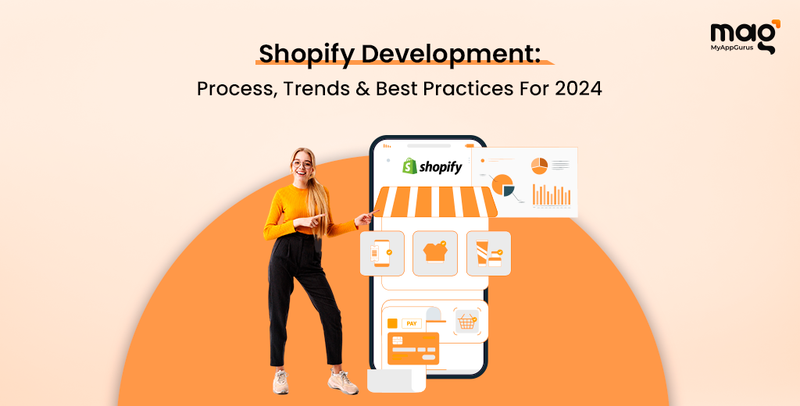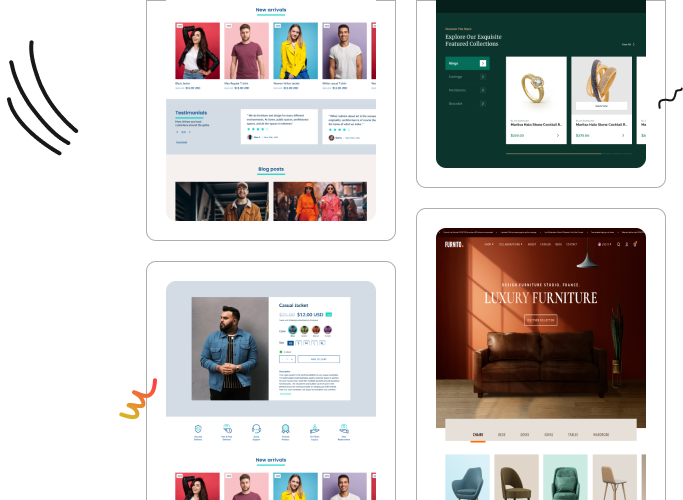Shopify Development: Process, Trends & Best Practices For 2024

Shopify remains the largest e-commerce platform that makes it possible for small, medium and large sized businesses to establish themselves on the digital realm. However, it is important to keep abreast of the Shopify development process because it is constantly changing.
Since 2024, the Shopify development process has made massive strides forward which have made it more developer-friendly as well as useful and accessible by the sellers. And to fully utilize the potential of this platform you should know the latest updates.
This blog post will try to explain what is happening with Shopify in 2024. It will look at current trends and give some advice on how to succeed with your Shopify development journey.
The Shopify Development Process: A Step-by-Step Guide
To build a viable Shopify store, you need to have a clear development process. Here is an outline of the stages usually followed:
Project Scoping and Planning
- Define what you want for your project, who it’s meant for and how it should operate.
- Research and identify the best apps and Shopify themes that will cater to your needs.
- If flexibility and customization are essential, think about headless commerce.
- Come up with a sitemap outlining the store’s structure as well as content hierarchy.
Shopify Theme Development or Customization
- Choose between ready made themes on Shopify Theme Store or create your own custom theme in order to have unique brand identity.
- You can use basic theme customization options that Online Store Editor suggests or hire Shopify developer to make major changes.
- Make sure that it is responsive across all devices (desktop, tablet, mobile).
Functionality Development
- Essential features such as product listings; shopping cart functionality; secure payment gateways; shipping options should be integrated into your system.
- Think of headless commerce integrations for an ultimate bespoke shopping experience.
- Custom functionalities can be created through Shopify app development or code injection.
Content Creation and SEO Optimization
- Develop catchy product descriptions, interesting blog posts, informative landing pages, etc.
- Apply SEO best practices to increase organic search ranking and drive potential customers to visit the site.
- Take advantage of built-in SEO tools provided by Shopify and also use other third-party integration for more advanced optimization purposes.
Testing and Launch
- Test all functions thoroughly using different devices and browsers.
- Make sure there is a smooth checkout process without any bugs or user interface inconsistencies at this stage
- Plan out how to launch the website so that customers can be attracted to it.
2024 Trends Shaping Shopify Development
In 2024, these are some of the key trends that will have a considerable impact on your project.
Headless commerce decouples the front-end storefront (presentation layer) from the back-end (logic and data layer). Thus, the design can be flexible as it would allow integration with content management systems (CMS) and other platforms.
Shopify has invested in things such as Hydrogen, which is a React-based resolution for building headless storefronts.
Social Commerce IntegrationSocial media platforms like Instagram and TikTok are fast turning into shopping destinations.
Your Shopify experts can integrate into these platforms to help your customers find out about products then buy them directly through the social media app itself thereby making shopping easier.
Progressive Web Apps (PWAs) for Enhanced Mobile ShoppingProgressive web applications (PWAs) function in the same way as internet browsers, however, they offer the same usage impression like a smartphone app.
Mobile shopping optimization should remain a priority in 2024.
PWA-based Shopify development leads to improved conversion rates and customer involvement on mobile devices as they offer faster load times, push notifications and offline functionality, hence better customer engagement.
AI and PersonalizationIt’s a major trend to use artificial intelligence (AI) in personalizing the customer journey. Product recommendations powered by AI, chatbots or dynamic content all make each individual’s shopping more interesting and tailored.
Focus on International ReachTo serve the international market, in 2024 Shopify development companies need to make sure they give priority several elements. These include
- multiple language stores,
- support for multiple currencies and
- localized payment options.
Augmented reality aids clients to virtually test products or see how they fit in their own spaces. This feature improves visualization of products and fosters confidence in purchase making.
Additionally, this leads to a more realistic view of products due to 3D product visualizations.
Best Practices for Shopify Development in 2024
Concentrate on Achieving Performance OptimizationTo retain customers in this era of heightened rivalry, a store that loads speedily is vital. Shopify experts need to focus on image optimization, code efficiency and the use of content delivery networks.
Increase SecurityThe security of any e-commerce store cannot be overemphasized. The use of SSL certificates, regular security audits, and trusted payment gateways are some of these best practices that guarantee customer information safety.
Make Use Of SEO Best PracticesIt is, therefore, imperative that Shopify experts optimize your Shopify store for search engines for better organic traffic.
This entails optimizing product titles and descriptions, using alt tags on images, as well as implementing a blog for content marketing.
Rely On Data And AnalyticsIn the current scenario, businesses must use data analytics for their decisions.
Shopify is one of the best ecommerce platforms, but its built-in analytics and Google Analytics often fall short of delivering the comprehensive insights needed for advanced marketing optimization.
This is where Littledata comes into action.
Littledata’s Shopify connection for Google Analytics 4 (GA4) combines client-side and server-side tracking for 100% accurate data. It seamlessly integrates with Shopify and Shopify Plus, capturing every customer touchpoint, including sales, marketing, and product performance data.
Additionally, Littledata connects first-party customer data to Google Ads, Meta Ads, TikTok, Pinterest, and Klaviyo, enhancing marketing attribution and performance.
Be Informed About New Features Of ShopifyConstantly, Shopify continues to improve the platform as they release new features and enhancements for Shopify theme development.
Developers who keep themselves up-to-date with these changes can leverage on them to optimize store performance and enhance user experience.
It also helps you get a competitive edge in the industry.
Conclusion
In 2024, the process of developing Shopify stores is a combination of strategic thinking, creative designing, and careful implementation.
By learning the constituents of the platform and following guidelines, programmers can build durable, scalable, and intuitive e-commerce websites.
If you are a seasoned coder or a business owner seeking an online footprint on the internet, mastering The Shopify Development Process is what will unlock full potential for your e-commerce activity in 2024.
